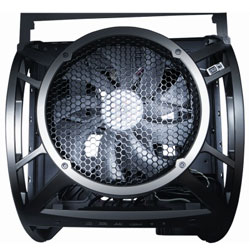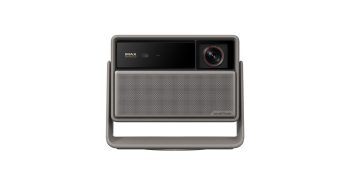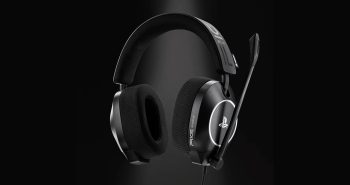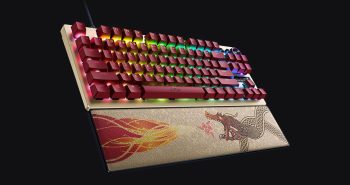 Open-air cases are the latest thing in PC gaming enclosures. For years, many gamers chose to run their PCs with the side doors open and large external floor fans pointed at the components. While this solution provided good airflow, the components are still all mashed into a vertical ATX PC case. Plus, you would have to worry about keeping enough space around the case to place the floor fan.
Open-air cases are the latest thing in PC gaming enclosures. For years, many gamers chose to run their PCs with the side doors open and large external floor fans pointed at the components. While this solution provided good airflow, the components are still all mashed into a vertical ATX PC case. Plus, you would have to worry about keeping enough space around the case to place the floor fan.
Antec has attempted to fix these frustrating issues with their first open-air case, the Skeleton. Looking like some sort of futuristic reactor more than PC case, the Skeleton features room for four internal drive bays as well as four additional drives along its side. The motherboard is seated horizontally on the upper-tier motherboard rack, which slides out the back of the unit like your friendly neighborhood server slides out of a rack mount, making reaching around different places of the motherboard easy. There is an issue with fan overhead however, and we found that tall aftermarket CPU coolers will not make the clearance given by the large 250mm unit. What this means is that you will have to use a shorter third-party cooler or the stock unit.
 The room is not nearly as plentiful in the below-mobo area where the PSU and internal drives are located, with snaking cabling about becoming a real pain at times. In addition, the way the PSU faces to one side takes away from valuable cable length when pulling cables to the opposite end of the case. These bottom-tier space issues aside, the ease of getting to your mobo components makes it well worth the trouble to be found underneath. Need to add a video card? Simply slide the component tray out the back of the unit and slap it in there, all easy like!
The room is not nearly as plentiful in the below-mobo area where the PSU and internal drives are located, with snaking cabling about becoming a real pain at times. In addition, the way the PSU faces to one side takes away from valuable cable length when pulling cables to the opposite end of the case. These bottom-tier space issues aside, the ease of getting to your mobo components makes it well worth the trouble to be found underneath. Need to add a video card? Simply slide the component tray out the back of the unit and slap it in there, all easy like!
The Skeleton comes equipped with two fan units. The most prominent being the 250mm Tri-Cool fan at the top of the unit. It draws cool air in and pushes it down onto the components below. Also included is a smaller 92mm fan which attaches to the front of the internal 3.5′ drive bay, providing hard drive cooling. It is important to keep the air moving underneath the motherboard as it acts as a barrier from the forced air coming from the 250mm fan above. By circulating the air underneath, this problem is alleviated.
Installing everything was actually fairly difficult. Not because the process itself is overly hard, but deprogramming myself after years of vertical ATX case installing took some time.  To make matters worse, Antec’s in-box documentation is not very good, and they refer you to the much more well-written online PDF. In the online document (available here) you will find color photos of the setup in action which are very helpful.
To make matters worse, Antec’s in-box documentation is not very good, and they refer you to the much more well-written online PDF. In the online document (available here) you will find color photos of the setup in action which are very helpful.
If you are like me, you have a ton of hard drives in your current PC case. With the Skeleton only supporting four internal drives (two 3.5” and two 5.25”) you may feel like you have run out of room. Do not fear, as the case allows you to mount up to four 3.5” drive bays on the outside of the frame using special mounts provided in the packaging. This solution, while a bit unconventional, does the trick nicely and keeps those drives easy to access.
Unfortunately, testing the Skeleton against the old-school open ATX case and floor fan would not be very scientific as reproducing the results would be highly dependent on fan model, age, etc. So, we turned to aluminum case maker Lian Li’s PC-X2000. This tall (and expensive) metal monstrosity is renown for its thin profile and cooling. Lets see how they stack up.
Temperature Rating (Lian Li PC-X2000 / Antec Skeleton)
Case Ambient @ Idle: 28C / 24C
Case Ambient @ Load: 30C / 24C
GPU @ Idle: 38C / 34C
GPU @ Load: 53C / 44C
 As you can see, the Antec Skeleton consistently provides lower temperatures than the Lian Li thanks to it being more exposed to a cooler source of air. Cool air just spends less time turning hot and lingering around the Skeleton due to its open design.
As you can see, the Antec Skeleton consistently provides lower temperatures than the Lian Li thanks to it being more exposed to a cooler source of air. Cool air just spends less time turning hot and lingering around the Skeleton due to its open design.
Overall, we did like the component cooling given by the Skeleton’s unique design as well as the easy access to mobo components when you slide the tray out. While not perfect, the Skeleton is a good purchase for gamers and PC tweakers out there. Just watch out for that overhead height limit with regards to the CPU cooler.




